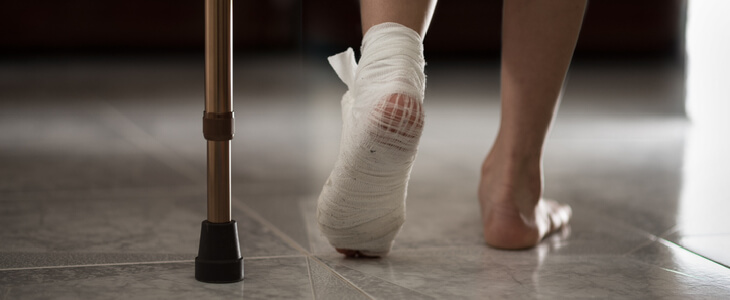Do you have a viable podiatry malpractice case related to a diabetic ulcer? If you live in New York and you suspect you do, you should immediately contact The Law Firm of Lawrence M. Karam, P.C. for a free consultation.
Founding attorney Larry Karam has spent decades successfully fighting for the rights of diabetic patients who have suffered long-term or permanent injury because of their podiatrist’s negligence. If you are a victim of podiatry malpractice that has resulted in a worsening of your condition, he will fight tooth and nail to recover the damages you deserve.
What Are Diabetic Ulcers?
A diabetic ulcer is an open sore or wound that occurs in approximately 15 percent of patients with diabetes. Diabetic ulcers usually appear on the foot or lower leg. Tragically, although research shows that foot ulcers can be prevented or healed, up to a quarter of patients who develop diabetic ulcers will require an amputation. Many factors put diabetics at risk for ulcers, including their reduced ability to feel pain (neuropathy) and poor circulation. The latter also slows healing.
How Common Are Diabetic Ulcers?
It is estimated that over 10 percent of the U.S. population has diabetes and that 15 percent of those with diabetes will develop diabetic ulcers as a result of the disease. In too many cases, some due to medical mistreatment, such ulcers worsen to the point that a lower extremity has to be amputated. This awful consequence is twice as likely to occur in Blacks and Hispanics.
As you might expect, diabetic patients with other complicating factors, like obesity, alcohol abuse, or smoking, and those with advanced disease progression, are at higher risk of developing diabetic ulcers. Even when treated promptly and correctly, ulcers may take many weeks or months to heal.
Defining Podiatric Malpractice
Medical malpractice is a treatment that, through commission or omission, deviates from the accepted norms of practice by professionals in the medical community. So, in the discipline of podiatry, malpractice refers to treatment, or lack of treatment, which deviates from the standard of care.
Steps Podiatrists Should Take to Treat Diabetic Ulcers Properly
Podiatrists are trained to be particularly alert to foot infections in diabetic patients and to treat them with extreme care. Once an ulcer is observed by a patient, the patient should seek immediate podiatric care in order to:
- Reduce the risk of infection
- Relieve pain, improve function and quality of life
- Avoid a potential amputation
In order to meet these goals, your podiatrist is expected to take whichever of the following steps are required under your particular circumstances:
- Be alert to any and all signs of infection, such as warmth, redness, tenderness or pain, swelling, and secretions.
- Prevent infection by careful wound care, including sterilization, and bandaging
- Avoid antibiotic therapy if the wound is not infected.
- Remove dead skin and tissue, known as “debridement”
- Take the pressure off the area (called “off-loading”) by having the patient wear special footgear, or use a brace, cast, wheelchair, or crutches while the ulcer is healing
- Administer a probe-to-bone (PTB) test to detect whether an infection has progressed to the bone (osteomyelitis)
- Perform any necessary surgical procedure to lessen pressure on the ulcer by shaving or excising bunions, hammertoes, or other deformities
- Consult with appropriate specialists, e.g. your endocrinologist to manage blood glucose, or a vascular surgeon to make sure there is adequate circulation for proper healing
- Arrange for hospitalization of the patient if it becomes necessary
- Only amputate as a last resort and administer a broad-spectrum antibiotic before the procedure
If your podiatrist has neglected any necessary steps, resulting in your serious injury, Larry Karam will work tirelessly to persuade the court that you have indeed been a victim of podiatric malpractice. He will use his formidable negotiation and litigation skills to try to bring you the compensation you are legally entitled to. If your podiatrist has amputated your foot or leg without sufficient cause, Larry will do everything possible to bring you meaningful compensation for your resulting permanent disability.
Damages The Law Firm of Lawrence M. Karam, P.C. Will Fight to Win
If your podiatrist has exacerbated the situation, resulting in harm to you that resulted in real financial damages (e.g. increased medical costs, loss of income), Larry Karam may well be able to recover substantial damages for all you have endured, including:
- Medical and rehabilitation costs
- Lost income, present and future
- Pain and suffering
- Permanent disability
- Extended nursing care
- Replacement services (e.g. house cleaning)
- Alterations to make your home accessible
- Permanent scarring or other disfigurements
- Loss of consortium
- Loss of enjoyment of life
If you have been through the anguish of losing a loved one to wrongful death as a result of a severely infected and/or amputated limb, Larry Karam knows that no amount of money will allay your grief. Still, he will fight to recover damages for final medical costs, funeral expenses, and loss of financial support to bring you a sense of justice.
Contact Our Experienced Podiatry Malpractice Attorney
It is challenging enough to live with diabetes and suffer from one or more diabetic ulcers without having to face mistreatment at the hands of the podiatrist you trusted with your care. Larry Karam is here to help you. He has an excellent reputation and a strong record of successful litigation, and you will not owe him any attorney fees until he recovers for you. Contact him now. He will take over all legal matters of your case so you can concentrate on healing.
The Law Firm of Lawrence M. Karam, P.C. successfully serves diabetic ulcer podiatry malpractice clients throughout New York.

